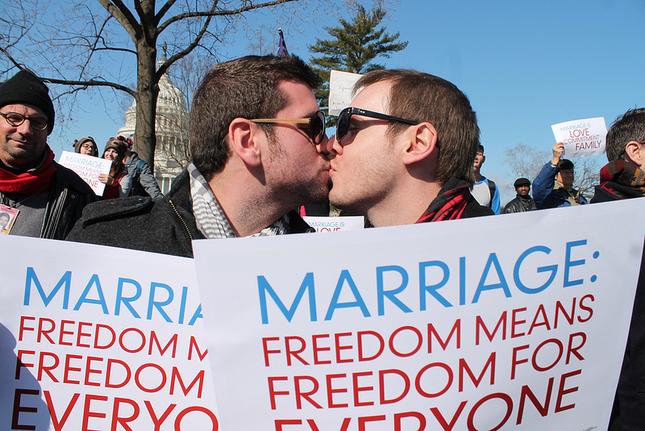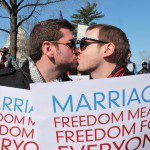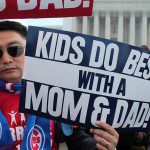Outside the Supreme Court for the Marriage Debate
By • January 16, 2015 0 1273

About 10 to 14 days ago, maybe even last weekend, and for sure Tuesday and Wednesday, America discovered gay marriage.
That’s not exactly true, of course, since the issue of whether gay couples should be allowed to marry has been around a few years, although not as many as you might think. It’s just that the last week or two seems to have turned the issue—the very existence and fact of it—into a portrait of a rising tide. The media was talking about it—it turns out according to respected polls that for the first time a majority of Americans approve of gay marriage, up considerably from a low 30 percentage or so several years ago. President Barack Obama, who went through what appeared to many a torturous process clearly indicated in his second inaugural address that he saw gay marriage as a civil rights issue and approved of it.
Former Secretary of State Hilary Clinton announced that she was for gay marriage. Former President Bill Clinton has said as much earlier, even though the Defense of Marriage Act–also known as DOMA–was passed during his administration. At the recent Conservative Political Action Committee gathering, Sen. Rob Portman, R-Ohio, once a high profile opponent of gay marriage, announced that he had changed his mind after his son had come out as a gay man.
This week, a whole bunch of people were talking about gay marriage, DOMA, gay rights, California’s Proposition 8, which bans gay marriage, about the rights to federal benefits by gay married couples. They also talked about the enduring power of love and snakes in the garden. Some of the talking was being done in front of the Supreme Court by attorneys, justices and plaintiffs. A lot of it was being done on the steps of the Supreme Court where a host of people had gathered for two days while the court heard arguments, pro and con, about overturning Proposition 8 and about restrictive aspects of DOMA.
On March 26 and 27, a certain kind of street theater was being performed outside the Supreme Court as it always does in this politically divided country when divisive issues are being argued legally here. The pros and cons, the antis and the for-it, the religious right, the liberal left, the principled conservatives, and principled liberals, the flag wavers and the sign-carriers, the young and the old, the rabid and the argumentative, always gather like colorful, visceral and verbal moths to the flame of history—along with tourists startled and pleased at being in the midst of history-making.
During these two days, there was a prevalence of couples—traditional man-woman couples and their children, not-traditional woman-woman couples and man-man couples, some of them also accompanied by their children. On the first day’s arguments, the divide seemed about as equal as it exists across the country, while the judges heard arguments for overturning and/or keeping Proposition 8 in place. The hard-line folks from a Topeka, Kan., Baptist congregation were there, taking a rest from demonstrating near military funeral sites but so were numerous couples, some of them long-married, having had to do so in Canada. The atmosphere, by written and video accounts, were often argumentative and loud.
On Wednesday, after judges had already seemed reluctant to initiate wholesale rulings on either subjects and often sounded reluctant to be in the position of making rulings on them, the atmosphere in front of the Supreme Court had changed. There were fewer people for one thing, and the arguments were fewer. The hard-liners, the shrill voices on either side seemed to have left. There was one man across the street waving a bible, acknowledging his sins, raging against reprobates, talking about Adam and Eve, quoting scriptures, even as he was argued with—and been heckled by—a group of young persons, some of whom surrounded him and yelled, “Take a picture of the freaks.”
Celebration seemed to be in the air more often than not. A woman weaved and bobbed through the crowd while her spouse held up a sign that read, “Equality Is Patriotic.” “Seven years and not a single person harmed,” she said.
Signed proliferated amid the gathering, most of them celebratory, urgent and insistent: “A Veteran for Everyone’s Rights,” “It’s Time For Marriage Equality,” “Equality Now,” “Blame My Straight Mother: she gave birth to a bi-sexual daughter,” “Equal Rights for all the Sexes,” “Devoted, Monogamous and Living in Faith,” “Love is Love” (by Stephen and John, married for 25 years) and “We’re Not Done Yet,” this sign by a student with an intensely celebratory, rambunctious group from American University.
A couple carried a bright sign that read, “The Young Are at the Gates.” They explained that it was a replica of a banner carried at a Susan B. Anthony demonstration for women’s right to vote.
“It’s a blessing,” one woman, said. “It’s inspiring to be here.” Valerie Brookhart, who is married to Army Major Savannah Brookhart, was here with her children, wide-eyed, one-year-old Aleks and three-year-old Charlie. “As DOMA stands, right now I’m not eligible for benefits should anything happen, and that’s just not fair.” The couple have been together for four years. Her spouse has served two tours in Iraq.
Another woman, who had managed to get into the hearing for “about five minutes,” said, “It was difficult to hear what was going on, but it sounded like some of the judges were unhappy to have the cases in front of them. “
We also saw activists Kesh Ladduwahetty, founder of Arts for Activists and First Amendment activist Mary Beth Tinker, who said she was here “to support equality.” “It’s amazing in some ways the rapid change that has occurred,” Tinker said. Tinker was part of a Supreme Court case with her brother and other students who wore black armbands to school in Des Moines, Iowa, protesting the Viet Nam war. They were banned from their school for refusing to take the armbands off. It became a Supreme Court case on free speech with the court ruling in the students favor.
It was a bright, cold morning, full of energy and speeches. Even opponents of circumcision showed up, dressed in white. A line of attorneys emerged from the court, walking down the steps, after the close of testimony, and the crowds cheered. “You don’t hear lawyers being cheered every day,” said one impressed spectator.
There was no decision, that day, only the reading of the runes by the media. It awaits a later day, probably in June. But it was also clear that something had changed in the country and that the mainstream, once easily recognizable, was becoming an even bigger coat of more and many colors.
Visit Elvert Barnes PROTEST PHOTOGRAPHY docu-project at elvertbarnes.com/protestphotography
- MARRIAGE EQUALITY RALLY in front of the US Supreme Court on First Street between Maryland Avenue and East Capitol Street, NE, Washington DC on Tuesday morning, 26 March 2013 | Elvert Barnes Protest Photography



